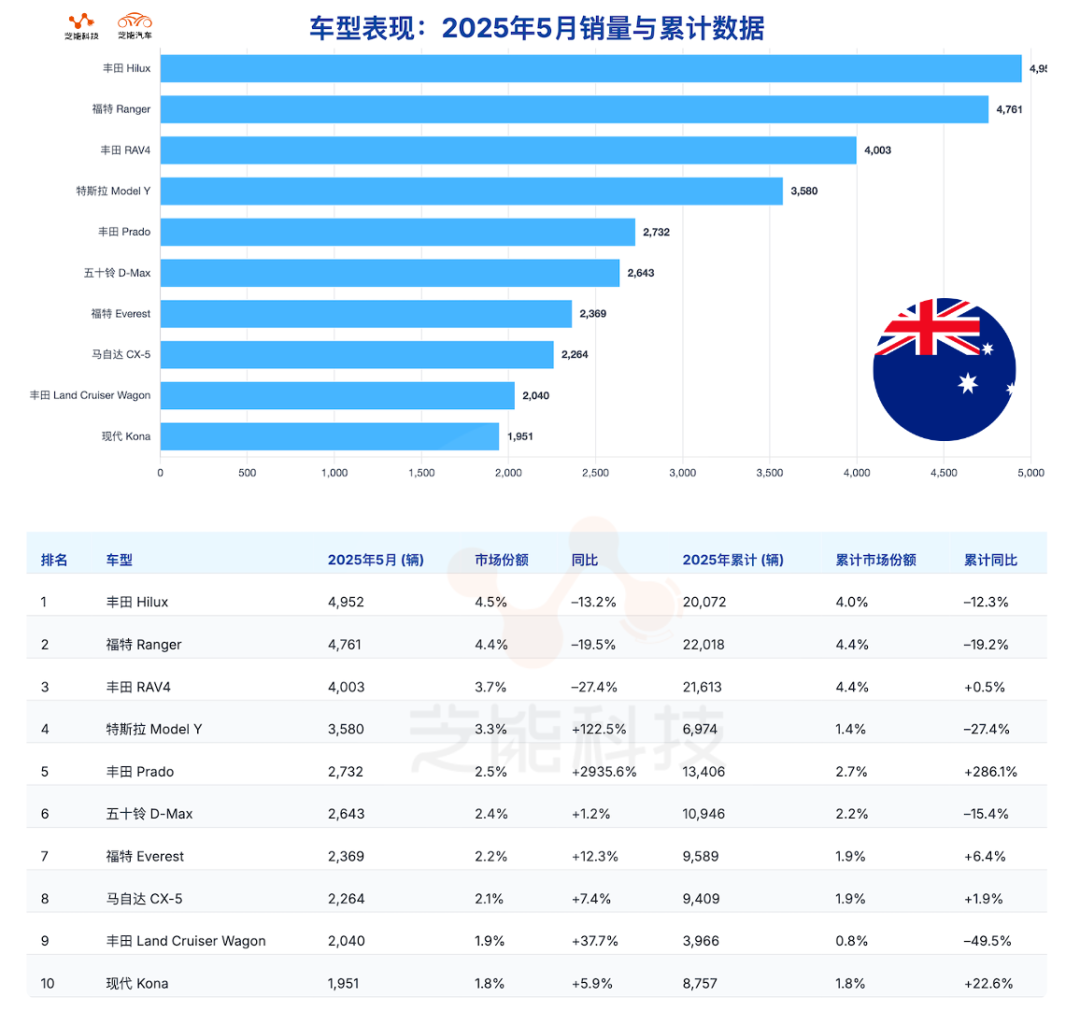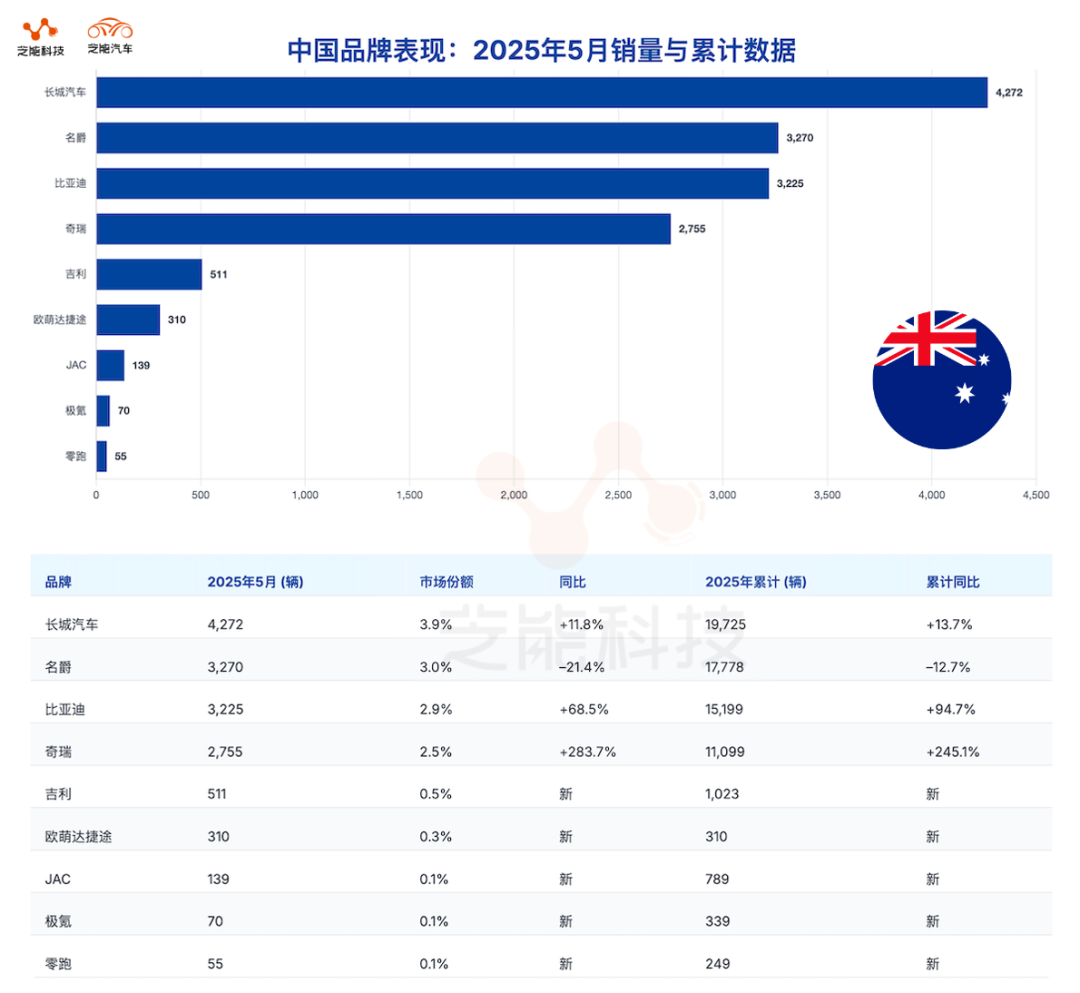Global Auto Market | Australia May 2025: Great Wall, Chery, and BYD Excel
![]() 06/13 2025
06/13 2025
![]() 438
438

In May 2025, the Australian new car market witnessed a 1.6% year-on-year decline but still achieved the second-highest May sales in history with 109,425 units sold.
Despite the overall market slowdown, Chinese brands shone brightly. Chery surged 283.7% year-on-year, BYD grew 68.5%, and Great Wall also recorded steady gains. Tesla's Model Y rebounded strongly with its new model, while Chery's Tiggo 4 Pro soared to 12th place, becoming the top-selling Chinese model in Australia.
This article delves into the new landscape of the Australian auto market and the strategic progress of Chinese auto companies, examining both the overall market performance and the development of Chinese brands.
01
Overview of Australia's Performance in May:
Localized Growth Amidst Structural Differentiation and Highlights from Emerging Forces
In May 2025, the Australian auto market sold a total of 109,425 vehicles, down 1.6% year-on-year. Despite the slight decline, it remained the second-highest May sales volume on record, just behind the 111,099 units sold in the same period of 2024.
From the Perspective of Purchasing Channels:
The private car market declined by 6.4%, while leasing companies' car purchases increased by 15.1%, becoming a crucial force in resisting the overall downward pressure. This underscores the contrast between weakening private consumption and staged replenishment on the corporate side.
From the Perspective of Market Segments:
◎ SUVs continued to strengthen their dominance, with sales reaching 67,440 units, up 12.9% year-on-year, and market share climbing to 61.6%, a significant increase from 55.8% in the same period of 2023.
◎ Light commercial vehicles declined 7.2% to 23,493 units, accounting for 21.5%, while sedans saw a sharp drop of 31.5%, selling only 14,565 units with a market share of 13.3%.
This trend indicates that Australian consumers are shifting preferences from traditional sedans to SUVs and crossovers offering more space and features.
From the Perspective of Powertrains:
◎ Gasoline vehicle sales fell 9% to 41,147 units, while diesel models declined slightly by 1.1% to 34,115 units.
◎ Hybrid models increased by 5.5% to 17,089 units.
◎ Pure electric vehicle models performed exceptionally well, with a year-on-year increase of 10.4% to 10,065 units, accounting for 9.2% of total sales.
Despite the withdrawal of tax incentives for plug-in hybrids (PHEVs) from April 1, sales surged 117.6% year-on-year to 3,081 units, indicating growing market acceptance of electrified products.

Sales Ranking by Model:
◎ Toyota Hilux retained its top spot despite a 13.2% year-on-year decline.
◎ Ford Ranger fell 19.5% but overtook RAV4 in cumulative annual sales to lead the year.
◎ Tesla's Model Y emerged as the month's biggest dark horse, soaring 122.5% year-on-year to rank fourth, refreshing its best ranking since March 2024.
◎ Toyota Prado surged unexpectedly with a staggering year-on-year increase of 2935.6%, rising to fifth place.
◎ Notably, Chery's Tiggo 4 Pro continued to make breakthroughs in the Australian market, rising from 20th place in April to 12th in May, surpassing MG ZS to become the top-selling Chinese brand model in Australia.
◎ While BYD's Shark failed to enter the top 20, ranking 22nd, it still demonstrated initial market penetration capabilities.

At the Brand Level:
◎ Toyota continued to rank first with a market share of 21.5%.
◎ Ford, Mazda, and Kia followed, all experiencing varying degrees of decline.
◎ Hyundai, despite a 3.3% increase, still ranked fifth.
◎ Notably, Tesla returned to the top ten with sales of 3,897 units, ranking ninth.
◎ MG fell to tenth place due to a 21.4% decline.
◎ While traditional brands faced overall pressure, emerging brands such as Mini, Lexus, Land Rover, and Porsche achieved significant year-on-year growth, demonstrating strong anti-cyclical capabilities.
In terms of Country of Origin:
◎ Japanese and Thai production brands still dominated, with year-on-year declines of 6.1% and 9.3%, respectively.
◎ Chinese brands, however, grew 27.1% against the trend to 21,381 units, approaching the market share of Thai-produced cars, reflecting the enhanced competitiveness of Chinese manufacturing in the global auto supply chain.
02
Comprehensive Acceleration of Chinese Brands in Australia, Led by Chery, BYD, and Great Wall
The performance of Chinese brands in the Australian market is entering an acceleration phase, particularly evident in the May 2025 sales data.

◎ Great Wall Motors sold 4,272 units, up 11.8% year-on-year, continuing to rank eighth and becoming the largest Chinese brand by volume. Although no specific models entered the top 20, as a diversified brand covering SUVs and pickups, Great Wall has achieved localized product layout in the Australian market. Its steady growth also paves the way for the introduction of subsequent premium brands such as Tank and WEY.
◎ Geely, a recent entrant to the Australian market, rose to 26th place, indicating its brand potential is beginning to be unleashed.
◎ Similarly, newly entered brands Omoda, Jetour, and Deep Blue ranked 31st and 42nd, respectively. While they have yet to form a significant scale, they provide valuable data for future multi-brand synergy.
◎ BYD maintained its strong growth momentum, selling 3,225 units in May, up 68.5% year-on-year, ranking 12th among brands. Although no models entered the top 20, its overall sales have been steadily increasing, particularly with its focus on new energy vehicles, which aligns with Australia's policy to promote electrification. Considering BYD's focus on pure electric vehicles, the 10.4% growth in the BEV market provides a favorable environment for its development.
◎ Chery sold 2,755 units in the month, a year-on-year surge of 283.7%, not only setting a new monthly sales record but also rising to 15th place in brand ranking. Its main model, the Tiggo 4 Pro, performed exceptionally well, jumping to 12th place and becoming the best-selling Chinese model in the current Australian market. The vehicle quickly gained mainstream market acceptance with its cost-effective configuration, SUV size, and design language tailored to Australian consumer preferences.
In Australia's typically mature right-hand drive market, the rapid rise of Chinese brands is supported by structural factors. The Australian market is highly sensitive to cost-effectiveness, especially in the SUV segment where demand for family cars is strong. By retaining advantages in intelligence and electrification while controlling costs, Chinese brands have achieved direct competition with Japanese and Korean brands. Continuous improvements in product reliability and after-sales networks have made Chinese brands more acceptable to local consumers, and the first-mover advantage of Chinese companies in pure electric and plug-in hybrid vehicles is increasingly apparent.
Summary:
The Australian auto market in May 2025 exhibited a highly differentiated situation amidst an overall slowdown. While traditional brands struggled to grow, Chinese brands demonstrated a trend of "concentrated outbreak." Led by Chery, BYD, and Great Wall, Chinese auto companies are rapidly building their market foundation by leveraging the strong categories and cost advantages of SUVs and electric vehicles.








